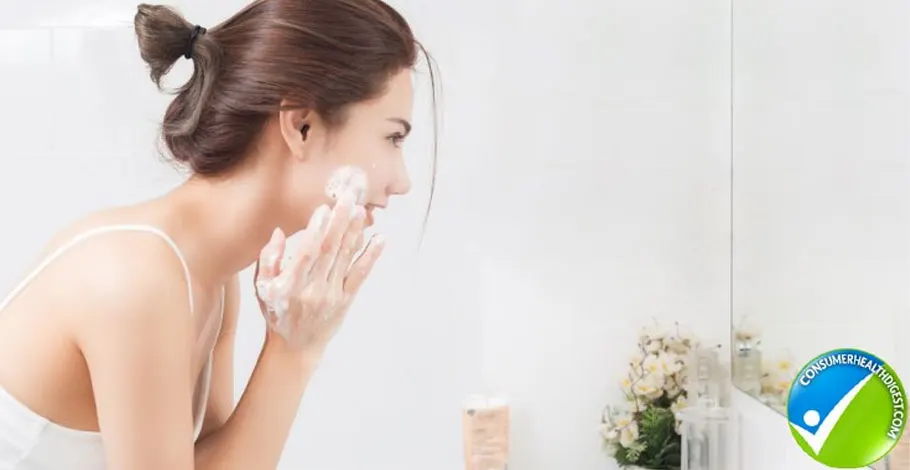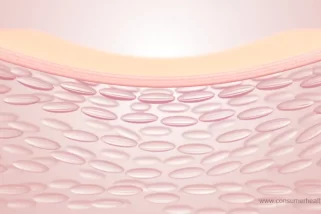In This Article
Bacteria Overview
Our skin, this moist envelope of our soul, is a living, breathing, and regenerating tissue. This miraculous medium is the real estate coveted by every cosmetic that aims to penetrate pores, solve insecurities, and systematize skin types. And yet, glowing, radiant looking skin evades so many.

Dry, oily, and combination skin, as well as common skin issues such as acne, blackheads, eczema, melasma, and premature aging and age spots are all manifestations of bacterial imbalance. Symptoms vary from subtle to severe, yet they all point toward skin microbial mismanagement.
Our skin is a tapestry teeming with microbes; we live our lives in perpetual bacterial bloom. A whole ecosystem resides on the surface and in the multilayers of our skin. Our cutaneous microbiome is in constant contact with the immune, digestive, nervous, and hormonal systems, and its disruption results in dysbiosis, which affects the healthy texture of the skin.
The unfriendly microbes that cause imbalances live on everyone’s skin. Yet, when microbial diversity mutates and plummets, pathogenic bacteria breed and trigger skin issues. Our skin needs bacterial diversity to thrive and to keep the flora friendly instead of fostering the frenemies that cause disruption and disease.
Only a few millimeters of skin separate our bodies from the outside world, yet the skin’s multilayered design provides us with the perfect protection. There are four main levels in the very thin, top layer of our skin called the epidermis. First, the outermost layer, the stratum corneum, keeps skin elastic and prevents water evaporation.
The second layer, the hydro-lipid barrier called the stratum granulosum, produces ceramides and phospholipids. The third layer, the immunologically active stratum spinosum, is a net-like layer that provides protection to the fourth layer, the stratum basale, which generates keratin and melanin cells and pushes them up to the outer stratum corneum every fourteen days.
The stratum corneum is composed mostly of dead cells, which has given rise to the practice of chemical peels and excessive exfoliation. Yet this vital layer is the topsoil that feeds our friendly flora. Cell loss is designed to precisely match cell production. Exfoliating cells away too quickly tips the balance and signals stress in the skin.
Our epidermal bacterial ecosystem requires a healthy stratum corneum because it is our most anti-aging and anti-infection layer. When we remove it prematurely, the young skin cells underneath are left vulnerable.

Stratum Corneum
With this juicy layer jeopardized, toxins and harsh chemicals irritate the new skin, inducing inflammatory issues. If this layer is disturbed regularly, as it is with daily exposure to synthetic cleansers and creams, it creates missing microbes, inflammation, abnormal cells, and easy entrance for toxins.
For decades we have known about the toxicity of modern toiletries and its effect on our skin, cells, and hormones. Now, revolutionary research about the skin’s microbiome reveals new levels of damage to our dermis that the daily doping of lotions and soaping is doing to the flora that support our skin. [1]
When the skin is injured, our native skin microbes invade the area to defend against nonnative pathogens, and this prevents infection. (This is a good reason to avoid antibacterial soap!) Bacteria also regulate skin collagen and protect the skin from UV damage.
Most modern skin care routines for clear skin often suppress the beauty of this symbiotic system. The bacteria domesticating our dermis are altered by what is applied topically. The daily rubbing and scrubbing of our skin with a diet of synthetic cleansers and creams fumigates our friendly flora. We disrupt the homeostasis when we remove protective bacteria and their food source of sebum, cells, and lipids.
Studies show that surfactants in cosmetics dissolve our skin’s natural ceramides, enzymes, and hydro-lipid barrier. These surfactants that make skin squeaky clean also insert themselves into the stratum corneum like splinters and stay there even after rinsing, initiating chronic degradation to this delicate layer. [2]
This creates a vicious cycle of dermal dysbiosis and premature skin conditions that are difficult to escape - redness, acne, melasma, dryness, and irritated skin.
These skin issues may send us seeking a dermatologist. Dermatology prescriptions are known to be steeped in side effects with low success rates of resolving skin aliments, and often spawn new ones. Among this arsenal are antibiotics, retinoids, and cortisone creams that deplete our bacteria teams. Restoring beneficial bacteria, rather than further depleting it, should be the key to all skin therapy.
For beauty’s sake, we must befriend our bacteria. Bacteria are the best beautician. By outsourcing our beauty routines, we let microbes micromanage our skincare with their beauty-stimulating secretions that clean pores, plump pores, and keep skin strong and supple. A healthy microbiome is your best friend forever and works like the best beauty cream ever!
A beneficial way to achieve beautiful skin
Aside from Photoshop, the most beneficial way to achieve beautiful glowing skin is to maintain a microbiome of beautifying bacteria by following these three steps: stop, seal, and seed.
Stop

Stop Using Synthetic Cosmetics
Stop using synthetic cosmetics. Give your bathroom a makeover and set free the toxic bottles of empty promises that claimed to quick-fix or correct skin type and advertised active ingredients with hype. There is no need for synthetics to feel fresh and be clean.
Stop using soap on skin. Seriously, no foaming the face and body with soap, ever, except pits and bits. We also want to stop showering in chlorine that kills friendly flora. If municipal tap water is pouring from your faucets, use a shower filter.
Finally, stop applying questionable “natural” products. Just because there is an image of lavender fields on the label does not mean the bottle is full of intelligent ingredients. Rancidity, refinement, and hidden ingredients mean that not all “naturals” nourish the skin. Know your source and do your research.
Seal
After we have stepped away from the bottles of synthetics we can bring in a bevy of botanicals. Plants are cosmic chemists, endlessly assembling the molecules of the world, and we live by the grace of this assembly. It is the life force of this plant perfection that we want to mix and meld with our microbiome.
Plant tissues are made up of cells that produce lipids and aromatic essences. These secretions are pressed and steamed from cells within the plant’s cells to produce botanical extracts. These oily secretions work synergistically with our cells and befriend our microbes.
The next step in sealing the skin is to repair the hydro-lipid barrier by washing with pure plant oils. It may seem strange, washing with oils, yet it is one of the top things that will turn your skin around. People think that oil will leave their skin feeling oily and less than clean, though this isn’t the case when organic, authentic, fresh-pressed botanical oils are used.
Pure, organic oils, such as gorgeous golden jojoba, are loving lipids that lubricate the skin so that makeup and dirt are gently whisked away and the hydro-lipid barrier is left intact. In fact, cleansing with these oils also stabilizes our beneficial skin bacteria and enhances protection from pathogenic bacteria.
Soothing serums of seabuckthorn and jojoba deliver skin-loving phospholipids and balance the biome to keep cells perfectly plump. When nature provides such exquisite and effective elements to graciously attend to our skin, we must see the use of synthetic cleansers as the definition of insanity.
Not all oils are created equally, though. There are many “natural” oils that will never go near my skin! Grapeseed, peach kernel, sunflower, and almond oils are often rancid and ineffective right off the shelf.
Seed

Intestines Gut Bacteria
The third step is to reseed the skin and the guts with beneficial bacteria. The skin and the guts are inexplicably bound, and both healthy skin and healthy guts are lined with billions of beneficial microbes. Gut bacterial imbalance results in chronic inflammation that can diminish collagen and contribute to rapid aging.
Research indicates that a flourishing body-wide microbiome, boosted by oral probiotics to help reintroduce some missing microbe species to improve diversity, can help skin be less sensitive to UV rays, prevent cell abnormality, regulate collagen production, and more! [3]
Researchers are developing ways to deliver probiotics for gut health and skin health directly to the skin, but we don’t have to wait! Simply open a probiotic capsule, add it to a plant-based skin serum, and apply. [4]
Nothing understands what healthy skin needs more than your innately intelligent bacteria. No chemical-cream will ever desire vitality for you more than a thriving microbiome. Bless your bacterial diversity and replenish your beauty with bacteria-friendly botanicals, and then revel in the perfection you were born with.
4 Sources
We review published medical research in respected scientific journals to arrive at our conclusions about a product or health topic. This ensures the highest standard of scientific accuracy.
[1] Grice EA, Segre JA. The skin microbiome [published correction appears in Nat Rev Microbiol. 2011 Aug;9(8):626]. Nat Rev Microbiol. 2011;9(4):244-253. doi:10.1038/nrmicro2537[2] Walters RM, Mao G, Gunn ET, Hornby S. Cleansing formulations that respect skin barrier integrity. Dermatol Res Pract. 2012;2012:495917. doi:10.1155/2012/495917
[3] Souak D, Barreau M, Courtois A, et al. Challenging Cosmetic Innovation: The Skin Microbiota and Probiotics Protect the Skin from UV-Induced Damage. Microorganisms. 2021;9(5):936. Published 2021 Apr 27. doi:10.3390/microorganisms9050936
[4] Puebla-Barragan S, Reid G. Probiotics in Cosmetic and Personal Care Products: Trends and Challenges. Molecules. 2021;26(5):1249. Published 2021 Feb 26. doi:10.3390/molecules26051249






